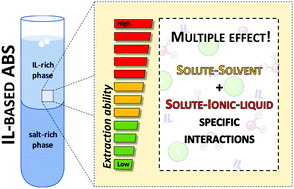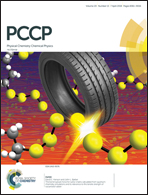Mechanisms ruling the partition of solutes in ionic-liquid-based aqueous biphasic systems – the multiple effects of ionic liquids†
Abstract
In the past decade, the remarkable potential of ionic-liquid-based aqueous biphasic systems (IL-based ABSs) to extract and purify a large range of valued-added biocompounds has been demonstrated. However, the translation of lab-scale experiments to an industrial scale has been precluded by a poor understanding of the molecular-level mechanisms ruling the separation or partition of target compounds between the coexisting phases. To overcome this limitation, we carried out a systematic evaluation of specific interactions, induced by ILs and several salts used as phase-forming components, and their impact on the partition of several solutes in IL-based ABSs. To this end, the physicochemical characterization of ABSs composed of imidazolium-based ILs, three salts (Na2SO4, K2CO3 and K3C6H5O7) and water was performed. The ability of the coexisting phases to participate in different solute–solvent interactions (where “solvent” corresponds to each ABS phase) was estimated based on the Gibbs free energy of transfer of a methylene group between the phases in equilibrium, ΔG(CH2), and on the Kamlet–Taft parameters – dipolarity/polarizability (π*), hydrogen-bonding donor acidity (α) and hydrogen-bonding acceptor basicity (β) – of the coexisting phases. Relationships between the partition coefficients, the phase properties expressed as Kamlet–Taft parameters and COSMO-RS descriptors were established, highlighting the ability of ILs to establish specific interactions with given solutes. The assembled results clearly support the idea that the partition of solutes in IL-based ABSs is due to multiple effects resulting from both global solute–solvent and specific solute–IL interactions. Solute–IL specific interactions are often dominant in IL-based ABSs, explaining the higher partition coefficients, extraction efficiencies and selectivities observed with these systems when compared to more traditional ones majorly composed of polymers.

- This article is part of the themed collections: PCCP Perspectives and 2018 PCCP HOT Articles


 Please wait while we load your content...
Please wait while we load your content...